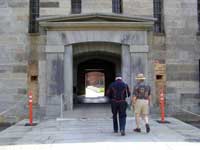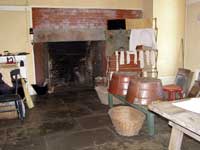Fort Delaware - Delaware Historic Site

In 1794, Congress first passed legislation providing for a permanent system of seacoast fortifications to defend against foreign invasion. The first of these programs were built of mostly earth with some masonry and deteriorated quickly once the threat of attack disappeared. Two examples of the early fortifications are Fort Mifflin near Philadelphia and Castle Williams on Governor's Island in New York harbor.
Construction of Fort Delaware, on swampy Pea Patch Island on the Delaware River, began in 1819 as part of Congress's newly approved Third System. These fortifications were built more methodically and were meant to be permanent. However, in 1831, Fort Delaware was destroyed by fire. By the start of the Civil War, Fort Delaware was rebuilt after being designed to be five times larger than any existing U.S. fort. The fort held Confederate prisoners of war from 1861-1865, with over 30,000 detainees passing through the gates. The fort was a dreaded place with inadequate food and a commandant, Brig. Gen. Albin Schoepf, who became known as "General Terror" due to his penchant for inflicting brutal punishment. In addition to the suffering caused by scurvy, malaria and smallpox, the Confederate prisoners had to endure horrible conditions caused whenever it rained. Rainwater would mix with the fort's sediment and create a putrid mix of worms, mosquitoes, dead leaves, dead fish and human waste. Despite these poor conditions, Fort Delaware was still not the worst fort to house prisoners during the Civil War and fewer detainees perished than at other locations.
Over the following decades, efforts were made to modernize the fort with up to date machinery and artillery. The fort was used during World War II to defend against possible invasion. Today the Fort Delaware Society and the Delaware Division of Parks and Recreation maintain the fort. Thousands of visitors come each year to view historic displays and reenactments. More about Fort Delaware...



